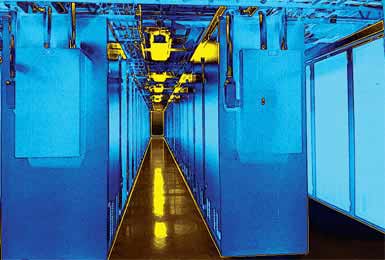Determining Facility Requirements for Mission-Critical Data Centers
Although there is no perfect data center site, by vetting prospective sites to see if they meet specific requirements, a company can find one as close to ideal as possible.
Q3 / Summer 2013

In other words, there is no perfect data center location. Acknowledging this at the outset allows the site selection team, including those internal to the company as well as their external advisors, to focus on determining which characteristics are preferred versus required, which flaws are fatal, and which can be mitigated at a reasonable cost. Budget, infrastructure availability, design requirements, and disaster risks demand compromises on every data center site search. However, where to make those compromises is a decision that is unique to each project and driven by the business objective of the facility (disaster recovery, financial trading, records storage, cloud applications, multitenant, etc.) and the individual preferences of the company, its CIO/CTO, and other team members.
The Need for Due Diligence
The need for due diligence, however, does not vary. Data center operations are highly risk-averse — it’s not possible to overemphasize this point. If there is one thing less tolerable than a known risk associated with a site, it’s the presence of an unknown risk. Mission-critical facility operators are rigorous in their review of potential locations.
Partners who understand the unique business structures, infrastructure requirements, and operating standards that drive mission-critical facilities, and who thus can effectively facilitate the due diligence process, are highly valued. This has led some utilities, developers, and economic developers to establish programs to proactively identify potential data center sites and have them vetted by an independent firm.
The location selection process and accompanying due diligence won’t result in a perfect data center location, but they will lead the company to the optimal location for the project. Additionally, any compromising on site criteria will have been done deliberately (rather than unintentionally), allowing the company to consider options for offsetting any less-than-optimal attributes, such as mitigating weak power redundancy infrastructure with enhanced back-up generation capabilities and utilizing economic development incentives to compensate for the additional cost.
Power, Speed, Uptime, and Talent Are Required
Many factors affect the selection of a data center location, but utility infrastructure, uptime, talent, and speed are always the focal points.
Utility Infrastructure
Few people are unaware of the large electric loads (usage) of data centers. Naturally, due to the amount of power they need, data centers are very price-sensitive to a location’s cost of electricity. The cost is more than centers per kWh, though. Data centers have unique ramp-up needs and reserved capacity demands. The utility’s ability to accommodate these requirements can have a significant impact on cost. Likewise, the mission-critical aspect of the data center, requiring it to be online at all times, drives rigorous power redundancy and reliability requirements. The utility’s “cost-to-serve” and revenue credit policies must be factored into the overall cost of providing the requisite power.
New Trend: Increased power requirements — Whereas previously, data centers may have only required 100W or 150W per square foot, many of today’s data centers must have between 200W and 300W per square foot. This presents problems for many existing facilities looking for new users, as the power distribution to and through the building was typically built for lower power densities.
Data centers also require robust fiber infrastructure. The speed at which data can be transferred to other locations (referred to as “latency”) is critical. Data centers also require redundant fiber routes to the facility and have a strong preference for multiple providers.
New Trend: Microwave technology — Microwave and millimeter wave technology are being deployed to move data faster, offering point-to-point transmission of data and avoiding the traffic and limitations of having to follow existing fiber routes. Financial exchanges, in particular, have been early adopters of these technologies. Microwave technology is allowing companies to consider locations once thought too distant or too remote for a data center.
The computer servers in the data center generate an immense amount of heat, driving the need for powerful cooling systems to prevent the computing equipment from overheating. Many (but not all) data centers use water-based technology for the cooling system, making a plentiful and cost-effective water supply an important location consideration. Increasingly, data center operators are utilizing outside air (“free cooling”) to cool the equipment, resulting in a focus on locations in cooler climates.
Uptime
Data centers are expected to be “up” and running at all times. No service interruption of any kind is tolerable, so data centers are extremely risk-averse. A thorough review of the potential for natural or man-made disasters will be an integral component of any data center site selection process. The need to be constantly online is also reflected in the redundancy requirements of the utility infrastructure and the ability of staff and vendors to be able to reach the data center at all times.
People
True, data center operations don’t focus as heavily as other industries on the availability of labor when choosing a new location. That should not, however, be interpreted to mean that IT talent isn’t a critical component in the facility’s success. Historically, most companies have made the assumption, and reasonably so, that due to the low headcount required to run the facility, they would be able to either locate the needed talent in the local market or relocate a few people to the chosen location.
New Trend: Need for IT talent — Increasingly organizations are collocating more staff with the physical data center. Companies providing Internet, cloud computing, or related services are locating sales staff at “customer experience centers” at the data center to showcase the company’s technological capabilities. Collocation facilities are providing office space for their customers’ IT staff and vendors. These trends, combined with today’s shortage of certain IT skill sets, is causing data center operators to place greater emphasis on labor considerations when siting a data center. This includes analyzing the availability of IT talent in the local market, as well as paying more attention to the attractiveness of the location and the building itself in order to attract top IT talent to work at the facility.
Speed
New Trend: Compressed Timeframe — As with many corporate projects in the current economy, it is frequently difficult to obtain internal approval to improve or acquire new real estate assets until and unless the need is urgent and critical. This hesitancy results in drastically compressed timeframes. Companies simply cannot wait while a utility or economic development organization looks for a site that, even if found, hasn’t been vetted. They want fast answers and a high level of confidence that there won’t be any deal-crashing surprises during the due diligence phase.
Project Announcements
Meta Plans Beaver Dam, Wisconsin, Data Center Operations
11/15/2025
DartPoints Expands Greenville County, South Carolina, Data Center Operations
11/15/2025
Lambda Plans Kansas City Missouri, AI Operations
11/11/2025
Google Plans West Memphis, Arkansas, Data Center Operations
10/14/2025
Ireland-Based Kerry Plans Lehigh Valley, Pennsylvania, Production Operations
10/07/2025
Italy-Based Vetagro Establishes Easton, Maryland, Production-Logistics Operations
09/25/2025
Most Read
-
The Workforce Bottleneck in America’s Manufacturing Revival
Q4 2025
-
Rethinking Local Governments Through Consolidation and Choice
Q3 2025
-
Lead with Facts, Land the Deal
Q3 2025
-
How Canada Stays Competitive
Q3 2025
-
Investors Seek Shelter in Food-Focused Real Estate
Q3 2025
-
America’s Aerospace Reboot
Q3 2025
-
The Permit Puzzle and the Path to Groundbreaking
Q3 2025

